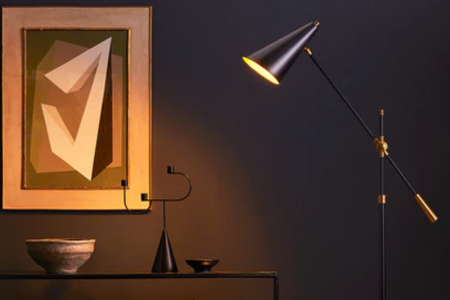 Wrappling standing lamp
Wrappling standing lamp
You don't need us to tell you that lamps and lighting are absolutely essential to the design of your beautiful sitting room. Designer floor lamps, or standing lamps, serve a double purpose: they can be gorgeous objects in themselves, and the light they make can determine the whole mood of the room. So buying the right floor lamp requires a bit of thought. Here’s Pooky’s complete guide to choosing a floor lamp for your living room – starting with five key questions to ask yourself when selecting a style, a base and a shade…
1. Do you want your floor lamp to make a statement?
A striking floor lamp can be a living room feature in itself – adding height, colour and character to a room - or it can be a more subtle addition, blending in to the furnishings and fittings. Basically, do you want your visitors to go, 'Gosh, look at that lamp!' or do you think that lamps are like Wimbledon ball boys (at their best when you don't really notice them)? Whether you decide to go for a statement floor lamp may well depend on the space you have available. A tripod floor lamp, for example, will work really well in a sizeable empty corner, but may take up too much precious floor space in a smaller room. Galore floor lamp
Galore floor lamp
Another option if you want the lamp to be a talking point is to go for a simple base, but then splash out on a large, flamboyant shade that will add colour and life to an eye-level space. A striking shade will look just as good in the daytime with the curtains was as it does when illuminating your after-dinner drinks.
2. How will the floor lamp fit with the scale of your living room?
When deciding on a floor lamp, you need to consider the scale of your living room – especially the height of the ceiling. If you have a low ceiling a very tall lamp can look out of proportion, while if you have a lot of overhead space a floor lamp that's too short will also stand out for the wrong reasons, dazzling guests with its glare instead of filling the room with ambient light. The trick, then, is to get a tape measure and work out your ideal height first, so that you know how tall the base can be before the standing lamp would start to dominate the room.
Mo floor lamp styled by Susie Atkinson. Image: Susie Atkinson
3. What kind of light do you want in your living room?
Standing lamps can be used for both task lighting and ambient lighting, so deciding which is the priority will help you to decide on the best floor lamp to go for. If you want your lamp next to a sofa or armchair to provide reading light, then the bottom of the shade should be at around eye level when sitting – meaning that the top of the lamp will typically be around 60 inches high when measured from the floor. Choosing the right shade is also important. A semi-translucent shade is ideal for softer ambient light, while if you want to highlight a wall or ceiling feature then go for an opaque shade, as these are better for decorative accent lighting.4. How will the floor lamp work with the décor and design of your living room?
Floor lamp bases can come in brass, wood, marble and a range of colours, while shades can be anything from understated linens to brightly coloured Ikat patterns on silk, so there is plenty of scope for matching your lamp to your living room’s style, period and décor. However, you can also use floor lamps to add character and new elements to your living room. Why not combine a standing lamp with a small armchair and side table to create a cosy reading nook?
Miami floor lamp in situ. Image: Artist Residence hotels
Floor lamps are also a great way to turn ‘negative spaces’ into positive design features. Those ‘nothing’ areas like an empty bay window or the gap between your sofa and wall can be lit, adding depth and character and bringing the room to life. Choose a semi-translucent shade to give a soft, diffuse light and create a warming glow. One more quick tip: when deciding where to place the floor lamp, take care not to obstruct the line of sight between seats. A splendid lamp is a fine thing, but you don’t want guests to have to crane their necks making chit-chat around it.5. Are you layering light with multiple lamps?
Interior design lesson 101 states that in a living room, layering light with multiple lamps is much better than relying on a single overhead source. Having several lamps of different sizes means you can use different combinations for different moods and situations. So if you are buying a floor lamp along with table lamps, desk lights and wall lights, there’s lots of fun to be had in creating a lighting ‘family’. They don’t all have to match, mind: craftily mismatched shades and styles can add a lot of personality to a room. There’s also budget to consider of course – which is where the Pooky range is ideal: you can mix and match shades and bases to create your own unique style, and while our lamps might look expensive, they’re designed to be affordable as well as distinctive…









